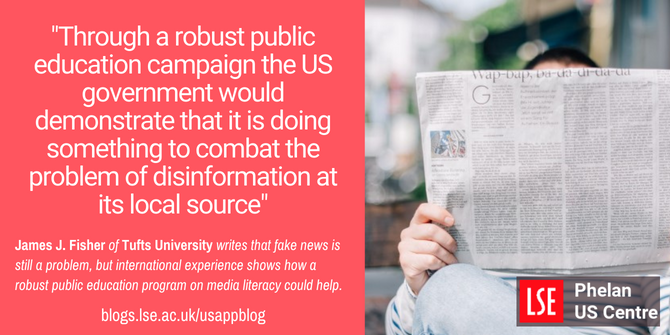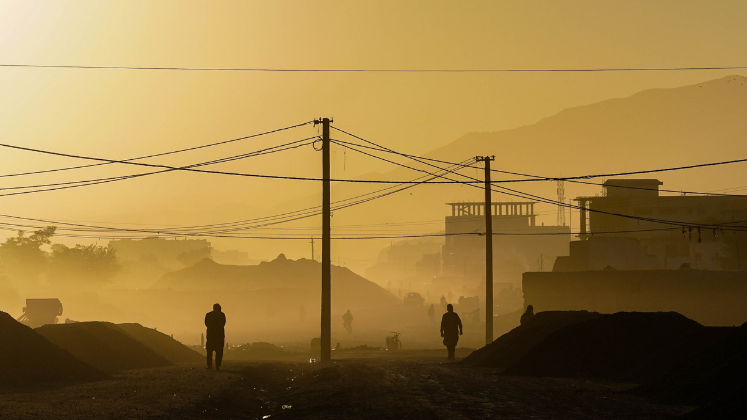 The challenges to American democracy posed by fake news and disinformation came to the fore during the 2016 presidential election – but the problem has not gone away. Looking to international examples of measures to tackle fake news, James J. Fisher writes that the US should learn from these and design and conduct robust public education campaigns on digital media literacy.
The challenges to American democracy posed by fake news and disinformation came to the fore during the 2016 presidential election – but the problem has not gone away. Looking to international examples of measures to tackle fake news, James J. Fisher writes that the US should learn from these and design and conduct robust public education campaigns on digital media literacy.
“But it’s the news, why does it matter where it’s from?” This question from one of my students in 2021—during a virtual course during the pandemic—shocked me into silence for a moment. They had turned in an assignment in which the class had to use several sources from journalists to examine the historical reasons behind a contemporary problem; this student had used two sources that were suspect, as they were from notably untrustworthy news sites. I realized, after talking to the class about their sources, that the students did not have a good grasp of digital media literacy. They had not been taught to sift journalism from disinformation or bias, and as a result they would forgo fact-checking their media sources and accept them at face value. This is a growing problem nationwide among the general public, not solely in the classroom. For example, only 38 percent of respondents in a media literacy survey reported learning how to analyze media messaging. Other countries have experienced similar challenges and in response, undertaken robust public education campaigns on digital media literacy. To combat this critical issue, the US government should do the same.
The spread of fake news
As we’ve seen in the 2016 and 2020 presidential elections, the general public can struggle to perceive the validity of reporting. For example, a study found that misinformation (i.e., “fake news”) indirectly influenced Americans during the 2016 elections as it was found to have affected the tone of fact-based media, with consumers being unfamiliar with how to differentiate them. This inability to differentiate truth from misinformation is especially evident on social media, where claims can often be repeated with little fact-checking. This is true across multiple platforms, as a report from the Brennan Center for Justice showed that each platform was used in different ways to spread disinformation ahead of and during the 2022 Midterm Elections—often through a concerted effort by a small number of connected individuals. This presents a problem for the government as well as the average citizen, due to the ease with which disinformation can be spread, whether by individual actors or state-sponsored efforts.
Public information campaigns to support digital literacy
Facing similar challenges, other countries have conducted public education campaigns, with positive results. What can the US, which has little historical experience with government-led public education campaigns, learn from these international models?

Photo by Roman Kraft on Unsplash
Potential models abound based on historical precedents to raise digital media literacy among both students and the public. Digital media literacy campaigns have become more common internationally in recent years, given the popularity of digital media and its global spread. During a trip to The Gambia in early 2023 as part of my doctoral dissertation fieldwork, I saw the aftereffects of two digital media literacy trainings conducted by the United Nations Educational, Scientific and Cultural Organization (UNESCO) and the Centre for Journalism Innovation and Development (CJID) (formerly the Premium Times Centre for Investigative Journalism (PTCIJ)). These trainings for Gambian youth leaders were done in 2019 and 2022, featuring sessions explaining the underlying subjects that citizens needed to know to evaluate political information from digital media. They highlighted aspects such as how the freedom of information and expression are key elements of liberal democracy but can often be at odds with fact-based information. Through these sessions, participants were taught fact-checking and verification of news sites and social media, as well as the opportunities and challenges that exist in digital spaces. Likewise, they also engaged in group assignments to reinforce the sessions and measure their understanding, as well as to evaluate their plans for spreading the knowledge that they’d gained in the sessions.
A recent UNESCO report has shown the impact of UNESCO’s and other organizations’ efforts to educate Gambian youth on media literacy and fake news in recent years. The 2019 and 2022 UNESCO/CJID trainings, among others, reinforce the notion that ‘fake news’ is an issue which Gambian activists and youth leaders have taken seriously and have clearly received support in understanding and undermining fake news in the nation.. In particular, the issue of misinformation has been critical to address since the 2016 Presidential elections that resulted in the ousting of the long-time dictator, Yahya Jammeh. The activists and musicians I’ve met and heard from have emphasized the need to understand what is and isn’t accurate political information, particularly amongst the youth. This was a key aspect of the trainings, as they emphasized the importance of media literacy for democratic participation. Emphasis was also placed on preserving the freedom of expression in the face of misinformation, as policymakers globally have attempted to regulate social media and other digital media in sometimes conflicting ways.
A 2020 study which conducted a media literacy intervention in the US via online panels shows the applicability of “relatively short, scalable interventions” as an approach that “could be effective in fighting misinformation” globally. The 2019 and 2022 UNESCO/CJID trainings can serve as potential models for public education intervention focused on digital media literacy in the US. This can be done by utilizing an independent, third-party organization, such as UNESCO (which the US has recently announced it intends to rejoin), to train students and other youth to recognize and combat misinformation. Due to the geographic and population size of the United States, these trainings would be best organized in counties and states which have suffered a disproportionate effect due to misinformation and ‘fake news’, rather than nationwide. In turn, trained students and youth organizers can help to broaden recognition of misinformation and “fake news” amongst their peers, especially through social media platforms such as Twitter and TikTok. As each participant learns from these trainings, they can then follow through by teaching their peers the same information.
Mass literacy campaigns
A second model that the US could draw upon is the concept of a mass literacy campaign, which has been popularized globally in the post-World War II era, particularly in the Global South. One useful historical model, which could potentially work in conjunction with the above UNESCO/CJID model, is Burkina Faso’s mass literacy campaigns of the mid-1980s. Under President Thomas Sankara, the national government set out to educate over five million Burkinabe over a decade. While Sankara’s presidency only lasted four years (1983-1987), the impact of his literacy campaigns were long-lasting: in a single mass literacy drive in 1986, for example, roughly 30,000 Burkinabe learned the basics of literacy. His education policies did not just focus on literacy campaigns, as his government also invested heavily in building schools and other educational spaces.
During my Master’s thesis research, which focused on Sankara’s presidency, I argued that a core element to his political ideology was the spread of education beyond urban centers into rural areas, especially emphasizing both adults’ and children’s education. The model presented in his literacy drives—brief campaigns which utilized both government actors and local educators—offer a potential example for a US digital literacy campaign. Through the utilization of existing resources, such as AmeriCorps’ education programs, a large number of educators could be brought together to engage students in schools and adults in the workplace in digital media literacy. A simple training exercise like the CRAAP Test, which helps to determine whether a source is credible, could be efficiently taught to a large number of Americans in a short period of time. In addition, by working with local non-profits like Rural Action, which operates in Appalachia, a more equitable approach could be given to reach areas often ignored by the government.
Protecting democracy by tackling disinformation
By better preparing Americans to understand the validity and credibility of digital media, the US can put itself on better footing to promote democratic engagement and lessen threats to our democracy. As we’ve seen in our national history—such as during the January 6, 2021 attack on the Capitol in Washington, D.C.—disinformation can quickly lead to political instability. Likewise, through a robust public education campaign the US government would demonstrate that it is doing something to combat the problem of disinformation at its local source. By educating more Americans on digital media literacy, the US can better prepare its citizens for the future.
- Please read our comments policy before commenting.
- Note: This article gives the views of the author, and not the position of USAPP – American Politics and Policy, nor the London School of Economics.
- Shortened URL for this post: https://bit.ly/44r73a1






